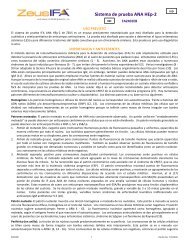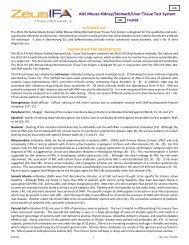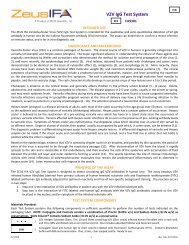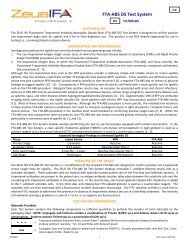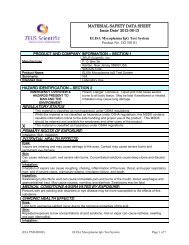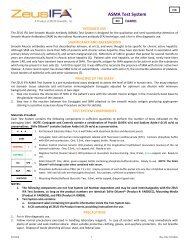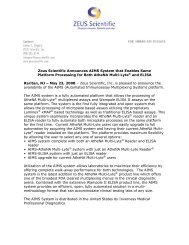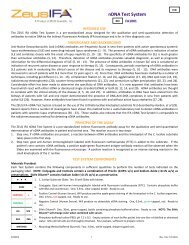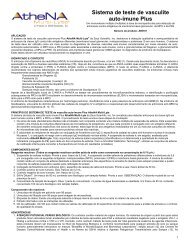B. burgdorferi IgG/IgM Test System - ZEUS Scientific
B. burgdorferi IgG/IgM Test System - ZEUS Scientific
B. burgdorferi IgG/IgM Test System - ZEUS Scientific
Create successful ePaper yourself
Turn your PDF publications into a flip-book with our unique Google optimized e-Paper software.
assay on such specimens (9). Lyme sera will be negative in these tests (9, 10). Also, when titered in the FTA-ABS test, syphilissera will show higher titers against the T. pallidum antigen than against the B. <strong>burgdorferi</strong> antigen (9).2. Patients with early Lyme disease may have undetectable antibody titers with this assay. In early Lyme disease <strong>IgG</strong>/<strong>IgM</strong>antibodies may not reach a level of diagnostic significance and may never do so when ECM is the sole manifestation (11). IfLyme disease is suspected early on, additional serum samples at varying intervals should be taken to demonstrate a rise in <strong>IgG</strong>titer.3. An alternative method for determining <strong>IgM</strong> antibodies may be more useful for diagnosing early Lyme disease or reinfection.4. Early antibiotic therapy may abort an antibody response to the spirochete.5. All data should be interpreted in conjunction with clinical symptoms of disease, epidemiologic data, and exposure in endemicareas.6. Screening of the general population should not be performed. The positive predictive value depends on the pretest likelihoodof infection. <strong>Test</strong>ing should only be performed when clinical symptoms are present or exposure is suspected.7. The performance characteristics of the <strong>ZEUS</strong> IFA B. <strong>burgdorferi</strong> <strong>IgG</strong>/<strong>IgM</strong> <strong>Test</strong> <strong>System</strong> are not established with samples fromindividuals vaccinated with B. <strong>burgdorferi</strong> antigens.EXPECTED RESULTSMost investigators agree that a cut-off dilution of 1:256 differentiates positive and negative results with a high degree of specificity,particularly in the later stages of Lyme disease (12). The 1:256 cut-off dilution was established in a study of 267 serum specimens.Of the 267 specimens, 177 were obtained from blood bank donors and 90 from non-Lyme disease patients (12 dermatologic, 2cardiac, 26 neurologic, and 50 patients with rheumatic diseases). One of the normal serum samples showed a titer >1:256, while 9produced titers >1:256 for a total of 10 out of 177 specimens. One out of 90 specimens obtained from subjects with non-Lymedisease disorders was >1:256; therefore, of the 267 sera tested, 1:256.PERFORMANCE CHARACTERISTICS1. The <strong>ZEUS</strong> IFA B. <strong>burgdorferi</strong> <strong>IgG</strong>/<strong>IgM</strong> <strong>Test</strong> <strong>System</strong> was compared to an ELISA assay in a double blind study at a large referencelaboratory. The results of this study are summarized in Table 1. The relative sensitivity and specificity of the IFA and ELISAassays in this study are based on specific diagnosis determined by clinical features and extensive laboratory workups of patientsin each disease category, i.e., all suspected Lyme disease patients demonstrated specific clinical features that were confirmed bypositive assays for Lyme disease antibodies.Table 1: Comparison of the <strong>ZEUS</strong> IFA B. <strong>burgdorferi</strong> <strong>IgG</strong>/<strong>IgM</strong> <strong>Test</strong> <strong>System</strong> and a reference ELISA AssayDisease Category Number <strong>Test</strong>ed IFA Positive ELISA PositiveB. <strong>burgdorferi</strong> ECMNeurologicArthritic1091018106910Autoimmune 112 5 2Other Infectious Disease 106 23 16The overall sensitivity for both methods was:*The overall specificity for each method was:**As compared to clinical diagnosis and other clinical laboratory data.2. These results show that the <strong>ZEUS</strong> IFA B. <strong>burgdorferi</strong> <strong>IgG</strong>/<strong>IgM</strong> <strong>Test</strong> <strong>System</strong> procedure is less sensitive in the early stages of Lymedisease (B. <strong>burgdorferi</strong>), particularly in those cases associated with erythema chronicum migrans. However, in complicatedcases of Lyme disease, the sensitivity was virtually 100% for both methods. These results are consistent with the lower amountof specific <strong>IgG</strong> antibodies present in the early stages of Lyme disease. These results are consistent with routine referralspecimens submitted for analysis at the reference laboratory. The study was conducted in a double-blind manner. The resultsof this study are shown in Table 2.Table 2: Comparison of the <strong>ZEUS</strong> IFA B. <strong>burgdorferi</strong> <strong>IgG</strong>/<strong>IgM</strong> <strong>Test</strong> <strong>System</strong> and a reference IFA ProcedureNumber Number Negative Number Positive<strong>Test</strong>ed <strong>ZEUS</strong> IFA Reference IFA <strong>ZEUS</strong> IFA Reference IFA50 38 38 12 12The results of this study show 100% agreement between the two procedures in detecting positive and negative sera using a 1:256dilution as a cut-off point.3. In a study conducted by the CDC (10), the IFA and ELISA methods for detecting antibodies in serum against B. <strong>burgdorferi</strong> werecompared employing serum specimens obtained during different stages of Lyme disease. The results are shown in Table 3.Table 3:Disease Stage IFA Positive ELISA PositiveECM 50 50Carditis 100 100Neuritis 92 100Arthritis 100 97More than one complication 71 8066%87%79%92%R2260EN 5 (Rev. Date 7/8/2013)



